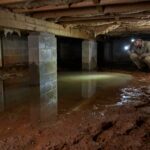Essential Guide to Foundation Repair: Ensuring Stability for Your Home
When it comes to owning a home, there are a lot of responsibilities that come with it—paying the mortgage, mowing the lawn, and of course, keeping an eye on the foundation. Yes, the foundation of your home is that unsung hero that provides stability, support, and peace of mind, all while remaining out of sight and out of mind… until something goes wrong. So, buckle up as we dive into the essential guide to foundation repair. You’ll learn everything from identifying the signs of foundation issues to understanding repair methods—and perhaps even some amusing anecdotes about why ignoring them can lead to catastrophic results!
Understanding Your Foundation
Before we delve into repairs, let’s talk about what your foundation actually does. Think of it as the sturdy pair of shoes that supports you during your daily adventures. It keeps your home upright, evenly distributes its weight, and protects it from environmental elements. Foundations come in various types, including slab, crawl space, and basement foundations, each with its own benefits and quirks.
But like a favorite pair of sneakers, foundations can wear out over time. They are vulnerable to various issues, particularly due to soil movement, water damage, tree roots, or just good old-fashioned age. Recognizing these signs early on can save you a headache (and a hefty repair bill) later down the line.
Signs Your Foundation Needs Repair
Homeowners often overlook early signs of foundation distress, thinking that it’s just a quirk of their charming abode. Here are the most common indicators that your foundation might be in trouble:
1. Cracked Walls: If your walls look like they’ve been through a bumpy roller coaster ride, it’s time to pay attention. Horizontal cracks in brick or drywall could indicate serious issues with your foundation.
2. Uneven Floors: Are you feeling a little wobbly when walking across your living room? Drooping or sloping floors can suggest your foundation is settling unevenly or has started to shift.
3. Doors and Windows Not Closing Properly: If your doors and windows suddenly feel like they’re auditioning for a horror movie by creaking and sticking, take note. This could signal significant shifts in your home’s structure.
4. Gaps Around Windows and Doors: If gaps are appearing where there shouldn’t be any, you might have a foundation issue on your hands. Homes should have snug frames—any gaps are a call for concern.
5. Water Accumulation in the Basement or Crawl Space: If you find yourself swimming in water instead of having a dry basement, this could signal drainage issues linked to your foundation.
6. Chimney Leaning or Cracking: If your chimney looks like it’s trying to dance away from your house, it could indicate a serious foundation issue.
If you spot one or several of these red flags, don’t panic! But do act promptly. Ignoring these warnings could turn a small repair into a massive fiasco that requires a second mortgage.
The Causes of Foundation Problems
So, what causes these sneaky problems? There are several culprits that could be damaging your home’s foundation. Here are a few of the most common:
– **Soil Movement**: Soil is fickle, fluctuating due to moisture levels and temperature changes. When soil becomes too moist or too dry, it can expand or shrink, resulting in shifts that affect the foundation.
– **Poor Drainage**: Water is a foundation’s worst enemy. If your gutters are clogged or rainwater isn’t properly diverted away from your home, it can erode the soil beneath your foundation.
– **Tree Roots**: Trees are lovely until their ambitious roots start seeking moisture and invade your foundation. Those roots can put pressure on your foundation, causing it to crack or tilt.
– **Heavy Structures**: Large additions to your home, like a massive deck or a swimming pool, can change the weight distribution and stress your existing foundation if not built correctly.
Foundation Repair Methods
Now that you’ve identified potential issues, let’s discuss how to remedy them. There are several methods for repairing a damaged foundation, depending on the severity of the problem. Here are a few common options:
1. **Piering**: This involves installing piers to provide additional support to the foundation. Typically, piers are driven deep below the ground and anchored to stable soil or bedrock. It’s like giving your home a solid pair of high-top sneakers.
2. **Slabjacking**: If your foundation is uneven but is made of concrete, slabjacking is a great option. This process involves injecting a material under the concrete slab to lift it back into position. Picture it as pumping air into a deflated tire.
3. **Wall Anchors**: For bowing walls, wall anchors can be installed. These anchors are fixed to a stable portion of your yard, providing extra support and pulling the wall back into a vertical position. It’s like giving a tired wall a solid hug.
4. **Drainage Solutions**: Sometimes, the best fix is preventing future issues. Adding drainage systems like French drains, sump pumps, or improving grading can redirect water away from your foundation and keep it nice and dry.
5. **Foundation Coating**: To protect against moisture, a waterproof coating can be applied to the foundation walls. This makes the foundation more resilient against water intrusion, like putting on a raincoat before stepping outside.
Choosing the Right Contractor
You might think you can tackle foundation repairs on your own, but unless you’re an experienced contractor, it’s best to hire professionals. Choosing the right contractor can feel like dating—it takes time to find the right fit! Look for companies that:
– Have good reviews and ratings.
– Provide free inspections and estimates.
– Are licensed and insured.
– Offer warranties for their work.
Prepare a list of questions to ask potential contractors, such as their experience with your specific foundation type, the methods they propose, and how long the project will take. Don’t forget to check their references, ask about previous projects, and make sure they have a clear plan for communication throughout the repair process.
Preventing Future Foundation Issues
Once you’ve tackled your foundation repairs, you may be wondering how to keep it safe moving forward. Prevention is always better than cure, especially when it comes to foundations. Here are some proactive steps you can take:
– **Maintain Good Drainage**: Regularly clean your gutters, extend downspouts away from the house, and ensure water doesn’t pool around your foundation.
– **Monitor Soil Moisture Levels**: If you live in an area with extreme weather conditions, consider installing irrigation systems or using mulch around the home to maintain consistent soil moisture.
– **Limit Large Plants Near the Foundation**: While trees are a great source of shade, plant them at least 10–15 feet away from your home to reduce the risk of root invasion.
– **Regular Inspections**: Keep an eye on your home. Regularly check for cracks, leaks, or other potential issues. An ounce of prevention is worth a pound of cure—or at least a less stressful and expensive repair!
Conclusion
In the grand scheme of homeownership, foundation repair might not sound glamorous, but ensuring the stability of your home is vital. By being vigilant and acting quickly when issues arise—and knowing when to call in the pros—you can maintain the integrity of your home and keep it safe for years to come. And remember, addressing foundation issues doesn’t just save you money; it also spares you the dread of “what’s that noise?” coming from the corner of your living room! So go ahead, give your foundation the love and attention it deserves—you’ll thank yourself later.


